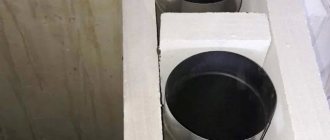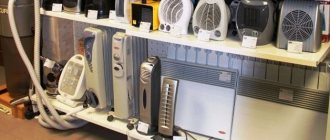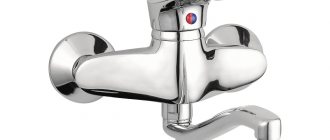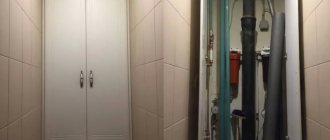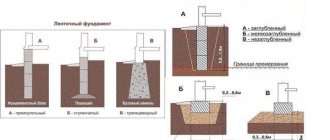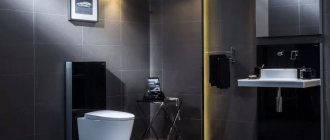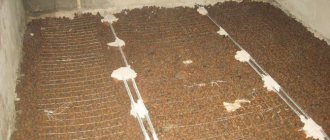Improper drainage - what you need to know?
Installing a sewer system is a very responsible undertaking. Mistakes made during sewer installation can cause many problems in the future. First of all, these are frequent blockages, which are not so easy to deal with. The second is the unpleasant smell from the sewer, noise when draining water, and much more.
When installing a sewer system, you should know where to lay the pipes, what slope angle they should have, and how best to position the siphon. Often, ignorance of the basics and rules leads to many errors, which, in turn, threaten a lot of alterations in the future.
A clogged sewer is a source of bad smell in the house ↑
Slow drainage or a complete lack of drainage from a plumbing fixture is often accompanied by an extremely unpleasant, putrid spirit emanating from the drain hole of the sink or toilet. The reason for this malfunction is a siphon clogged with all sorts of sewage.
Causes of odor and methods of control ↑
During the operation of plumbing equipment, fatty deposits and small household debris adhering to them accumulate in the bent elbow of the drain pipe, as a result of which a dirt plug forms in the siphon, preventing the normal flow of waste water.
The liquid, deprived of the opportunity to freely pass through the system, stagnates; in the cloudy warm environment, bacteria begin to multiply intensively, which, in the process of their vital activity, emit those foul-smelling gases that poison the air inside the room.
To remove clogged pipes with your own hands (depending on its location and degree of obstruction), you can use:
- mechanical means - plunger or plumbing cable;
- manual cleaning, which involves disassembling the siphon and washing its elbow;
- hydrodynamic installation;
- household chemicals or improvised home remedies.
Disassembling and washing the siphon
Clearing blockages mechanically ↑
A simple plumbing device - a plunger - will help push through a loose dirt plug stuck in the drain pipe elbow. This “device,” which is a small bowl-shaped nozzle mounted on a wooden or plastic handle, does an excellent job of removing blockages that form at the very beginning of the sewer drain.
Working with a plunger is very simple. First, you need to place a rubber cup exactly above the drain hole of the clogged plumbing fixture, then quickly press the handle 3-4 times and sharply tear the suction cup away from the drain. The water inside the “cup” of the plunger will partially destroy the dirt plug, and the negative pressure formed as a result of separation will suck its remains out.
If the blockage is more serious and located “downstream,” then you can use a plumbing cable to remove it. Such a device, when inserted into a clogged pipe, breaks the plug into small fractions, which are moved through the system by a stream of water and discharged into a sump, which quickly eliminates the smell in obtrusive sewer pipes.
Plunger and plumbing cable
Household chemicals and home remedies ↑
To dissolve small deposits on the walls of pipes, you can use soda, boiling water, vinegar or dishwashing detergent. More dense blockages are effectively removed by special gels, liquids or granules designed for drain cleaning
Such products containing aggressive acids or caustic alkalis require special care when using
When choosing a product to clear a blockage, carefully study its label. Instructions for use must be printed on it, as well as the type of pipe (plastic or cast iron) for which it is intended.
Home remedies to clear clogs
Sewer cleaning using the hydrodynamic method ↑
This most modern innovative technique allows you to easily remove even particularly stubborn blockages, but, unfortunately, it is impossible to use it yourself, although the cleaning technology itself is not complicated. The process of breaking through blockages in this way is performed as follows:
- Mounted on a truck chassis or loaded into the trunk of a pickup truck, the hydrodynamic unit is delivered to the job site by employees of a sewer cleaning service company.
- Specialists insert the machine nozzle fixed on a thin flexible hose into the clogged pipe and turn on the “heart” of the installation - a heavy-duty pump.
- Then everything happens automatically. Under the influence of jet thrust generated by water pressure, the nozzle rushes forward and, as it moves, destroys all obstacles encountered in its path.
- After cleaning is completed, the operator only winds up the hose, and the pipe becomes suitable for further use. In 90% of cases, the smell from sewer pipes disappears after this procedure.
The principle of operation of the nozzle of a hydrodynamic installation
Restoring the absorption capacity of the soil
If water does not leave the septic tank, flush it so that the soil begins to filter the liquid again. All contents are pumped out and the pit is filled with clean water. Allow to stand for a day, trying during this time not to discharge wastewater containing chemicals, especially those containing chlorine.
The next stage is the introduction of live bacteria. These are catalysts for natural decomposition processes occurring in any storage or treatment facility. There are natural microorganisms there, but the processing speed is insufficient. The introduction of artificially grown bacteria accelerates the decomposition of organic matter.
In this case, it is necessary to liquefy solid sludge, which prevents liquid from penetrating into the soil. It is partially washed away by fresh, clean water, but the main work is done by microorganisms. They eat old sediment, the remains of which can be removed after processing by bacteria.
Priming.
There are many biological products on the market for different purposes. Septic Shock Bioforce is recommended for liquefying solid sludge. The additives contained in the product contribute to the rapid development of bacteria, which are released into the septic tank. The container is designed for a volume of 1 m³.
Doctor Robik 509 is a product with a similar effect, the packaging is also 1 liter, but enough for 2 m³ of capacity. The drug has a winning price - about 600 rubles. per bottle instead of 900 rubles. for a similar product Septic Shock Bioforce.
In the future, fermentation is constantly maintained with the drug Doctor Robik 409. The bottle is designed for 2 m³, the drug is administered at a wastewater temperature above +4ºС. Use according to the manufacturer's instructions.
All bacteria, including artificial ones, are classified as aerobic and anaerobic. The former live only in the presence of air, so the cesspool must be ventilated. Anaerobics do not need oxygen, but their degree of wastewater purification is lower. Any of these bacteria are not suitable for restoring the absorption capacity of soil at low temperatures - they live at +4...+30°C.
Why does the toilet smell like sewer, how to get rid of the smell
Why does the toilet smell, causes of sewer smell
If an unpleasant odor suddenly appears in the toilet, then there is no point in trying to solve the problem with air deodorizers. This will only give a short-term effect that will last only a few hours.
- problems with water seals;
- incorrect sewerage configuration created at the design or installation stage;
- formation of hidden leaks;
- pipeline blockage.
If there is a sewer smell in the toilet, the reasons should be found out as quickly as possible.
Correcting errors made during installation
The discovery of these deficiencies often leads to the need for partial or complete repair of the sewer system. If the occurrence of an unpleasant odor is associated with improper design or installation of the sewer system, then it will have to be disassembled and reassembled.
The biggest problem arises when the angle of inclination of the pipeline is violated. In this situation, sewage can remain in the pipes, causing not only an odor, but also leading to the proliferation of harmful microbes. It will not be possible to quickly eliminate this problem - you will have to completely change the sewer pipeline, starting from the main sewer and ending with the plumbing fixture.
To avoid making the same mistake again, before laying a new sewer pipeline, you need to draw up a detailed design for the location of the pipes, taking into account the required angle for each section.
The tightness of plastic pipe connections is ensured by the use of special couplings and silicone sealant. The connections of cast iron pipes are caulked, or rather, processed using blows with a special chisel.
Eliminating odor if the water seal is not working properly
In the sewer system, unpleasant odors are usually contained by water seals. They represent a section of water in a curved section of pipelines. The unpleasant smell from the sewer is not able to penetrate through the plug formed by water. The water plug itself does not emit an unpleasant odor, since it is constantly updated with a new flow.
- formation of blockages even in pipes of normal cross-section;
- incorrect design of pipelines (in this case, pipes of a smaller cross-section are used than those provided for by the standards for plumbing fixtures), as a result of this it will be necessary to completely change the element right up to the entrance to the collector.
Disruption of the normal movement of wastewater due to icing of pipes. The solution to this problem can be their thermal insulation (for example, mineral wool) or heating (for example, a heating cable).
How to get rid of leaks
Often hidden leaks do not lead to a flood, but simply cause an unpleasant odor. Finding the place is not easy, since it can also be hidden in the interfloor ceiling. When searching for a leak, you must carefully consider all pipelines and their connections. Visual detection can be made easier by using a brush and soapy water. A solution is applied to the joints, and then water is turned on. Then the pressure in the pipelines is measured and soap bubbles are formed in places of hidden leaks.
Eliminating problems associated with poor ventilation
Sometimes an unpleasant odor occurs not because of problems with the sewage system, but because of a lack of ventilation. This problem can be solved quite easily; it is enough to simply make a temporary or permanent ventilation system.
If there is regular ventilation in the bathroom, then its performance should be checked regularly, at least once every few months. This is done simply: a piece of paper is applied, and it should deviate from the hole. You can do exactly the same thing with a burning match, whose fire should fluctuate.
It happens that ventilation is initially created incorrectly, so the only way out is to increase the movement of air flows using fans.
Leaks in sewer pipes
Plastic or cast iron sewer pipes are connected to each other using a socket method. O-ring rubber seals are installed in the gap. And although the material of the latter is designed for a long service life (tens of years), for one reason or another, the connection may begin to leak waste, which, accumulating, begins to smell bad.
In cast iron pipes that have been in use for a long time, leaks can occur not only in the joints of the joints, but also in the body of the metal. Long-term corrosion can corrode their thick walls until through holes appear. The only way to eliminate odor from leaks is to locate them and fix them by replacing the seal or repairing the leak with clamps or sealants.
How is the ventilation system discharged through the roof?
The work plan is very simple: first, a ventilation riser is installed on the upper floor. Then an end pipe is installed on the roof. And the last step is to connect the upper section of the ventilation pipe to the lower part of the end cap. This is usually done using corrugation, but some people prefer to use other materials, since corrugation is easily deformed - just an accidental finger press is enough. The material can also easily become perforated.
The roof end pipe is also easy to install. A special hole is cut in the roof, and two pipes in it are connected using a special cuff - an elastic adapter. All edges are treated with sealant. And finally everything is held together with screws.
Roof ventilation is a reliable, forever system that is low cost and easy to install.
How to remove sewer smell when clogged?
The second most popular problem is a blockage in the pipes or siphon. Most often, blockages occur as a result of improper installation of pipes, the ingress of residual fat, which, enveloping the pipes from the inside, creates a “cap” on which the rest of the debris sticks. As a result, water simply cannot pass through the sewer normally, it stagnates, bacteria grow in it, resulting in an unpleasant odor.
To remove the blockage, you can use suitable chemicals, but there are also traditional methods that can also be used - they are effective and safe. For example, you can use regular boiling water and dilute detergent in it. Baking soda also works well for removing accumulated grease: pour a glass of the product into the drain hole and pour 600 ml of boiling water.
Soda for fighting blockages
For more serious blockages, you should use vinegar. Pour 100 g of soda into the drain and pour 100 ml of vinegar. Then close the drain with a stopper - after half an hour, pour a liter of boiled warm water into the sewer. This effective remedy will help you forget about the unpleasant smell in the sewer.
Another option for fighting is a plumbing cable. We insert one part of the cable into the pipe and push it inside, turning the cable handle clockwise as we move. After completing the event, remove the product and remove dirt from it. In difficult cases, it is better to repeat sewer cleaning. It’s easy to check that there is no blockage - open the water tap, and if the liquid drains normally, then everything is in order.
2
Correct installation - working on mistakes
To identify installation errors that lead to blockages and the smell of hydrogen sulfide, you should know the basic rules for sewerage installation:
1. The toilet is connected to the riser at a separate entry point below all other devices. The remaining devices are connected higher; there can be several devices on one line, if bandwidth allows.2. The diameter of the outlet from the toilet is 100 mm, the riser should not be narrower. The diameter of the remaining connections is no less than the diameter of the outlet pipe from the plumbing fixture, and preferably 70 mm.3. The distance between the toilet and the riser is no more than 1 meter. Other devices can be installed at a distance of no more than 3 meters.4. If it is necessary to make a connection to the riser at a distance of more than 3 meters, it is made from a pipe of 70 mm or more. The thickness of a 5-meter line is at least 100 mm.
Optimal operation of the sewer system without blockages, with normal flow and absence of odors will be ensured by compliance with the slope and height difference. The horizontal slope of the sewer pipe depends on the diameter: for 50 mm - 3 cm per linear meter, for 100 mm - 2 cm. The maximum height differences should be 1 m for the toilet, 3 m for other devices.
A common mistake is to use 90° shaped corners to design turns, in which water bounces off, which contributes to the rapid formation of blockages. To create a smooth flow, 135° turns are used.
Mistake #6
When connecting pipes, it is necessary to use a special lubricant that ensures smooth and correct insertion of the end of the second pipe into the socket of the first. If you do not lubricate the end of the second pipe, the sealing collar (the rubber inside the socket) may become wrinkled or distorted, which will lead to a leak in this place, as well as the accumulation of solid deposits and clogging.
Instead of special plumbing lubricant, you can use a soap solution (regular soap or dishwashing detergent). It is prohibited to use silicone sealant for lubrication, since when it gets inside the pipe and after drying, it creates an obstruction to the drains, which can cause the accumulation of solid particles in this place and further blockage.
Valve installation
Installation of the ventilation valve.
An additional, but often necessary, barrier to eliminating sewer odor in the house is the installation of a ventilation valve. The valve operates in such a way that when closed it closes the pipe and prevents the penetration of odor from the sewer system. When draining, it opens for a while, without interfering with its operation, and restores the necessary pressure in the pipe. Such a valve is installed above all plumbing fixtures across the sewer pipe. You can purchase a ventilation valve in a specialized store at an affordable price, or you can make it yourself without spending a lot of time and effort.
The vent valve consists of an airtight seal and a low-resistance spring. To make such a valve at home, you can use any suitable materials and tools, for example:
The diagram is an example of a blockage and removal of a sewer.
- a small spring from an automatic handle;
- polyethylene lid for jars;
- a small piece of thin foam rubber;
- self-tapping screw, 45 mm long;
- electric drill;
- awl;
- scissors;
- glue "Moment".
Using scissors, cut a circle with a diameter of 50 (mm) from a polyethylene lid for jars, in the center of which, using an awl, make a small hole for a self-tapping screw. Using scissors, you need to cut a circle out of foam rubber with a slightly larger diameter - 60 (mm) and make the same hole in the center. Then both circles should be glued together with Moment glue.
Now in the cover of the end tee, with a diameter of 100 (mm), it is necessary to drill 3 holes, each with a diameter of 5 (mm). These holes should be located at a distance of approximately 25 (mm) from the center of the end tee cover. The valve is assembled in such a way that the spring placed on the screw should rest against the plastic circle, and the screw itself should fit into the prepared hole located in the center of the circle.
Then you need to check the operation of the valve. To do this, blow into the holes made. A good indicator would be the free passage of air through them. Otherwise, you can adjust the valve by unscrewing the screw and loosening the spring slightly.
https://youtube.com/watch?v=pF7lwiahy0s
Thus, the coordinated and high-quality operation of the autonomous sewer system of a private house will be ensured by a thoughtful installation of the ventilation complex.
Mistake #3
Selecting the correct pipe diameter. The standard cross-section used for laying external sewerage in domestic conditions is 110 mm, although there are pipes with a diameter of 16 cm and larger. Why shouldn't you use larger diameter pipes? The fact is that most septic tanks provide a connection with a diameter of exactly 11 cm. If you take a pipe of a larger diameter, then you will need to use an adapter to connect to the septic tank. Over time, dirt will begin to accumulate in this place, which can lead to blockages and other unpleasant consequences.
Causes of sewer odors in the apartment
In apartment buildings, the basic stench is formed for two main reasons:
- Excessive pressure in the public sewer system. It occurs as a result of a clogged riser. The ventilation of the main drainage pipe stops working. Large volumes of organic substances and water accumulate in it, which displace the accumulated musty air. The paths of its movement are into apartment pipelines. Air enters the room through leaky connections and water seals. The fact that gaskets and cuffs stably hold drain water does not serve as proof of the absolute strength of the docking units. The return air is under pressure with a large supply of kinetic energy. He easily finds gaps in the apartment's sewerage structure. The most vulnerable place is the bathroom. Due to the lack of free space, the water seals here have minimal dimensions. Water, which acts as an obstacle to the passage of air, due to its small volume is easily squeezed out and the air freely penetrates into the bathroom, and from there the smell from the sewer ends up in other rooms.
- Air vacuum in the riser. Its upper end is discharged into the technical room (attic) into a vent pipe. The incoming air creates natural ventilation in the pipeline. If the pipe is covered (often as a result of large construction debris), air access is limited. The drainage from the apartments displaces the air remaining in the riser. A highly rarefied space is formed, which draws water out of the siphons, opening the way for air. Soon the smell of sewage appears in the apartment.
In addition to problems with the riser, which must be solved by specialists, there are other ways for odor to penetrate from the sewer into the apartment. Among them:
- Complete or partial blockage of drainage pipes in the owner’s apartment. Wastewater forces air back into the room. For reasons already noted, the smell spreads in the bathroom. It also comes from the sink, toilet and washbasin.
- Malfunction of sanitary fixtures. Most often this concerns the toilet. The tank is not completely filled with water. Partial drainage of organic matter occurs, some of which gets stuck in the pipe. It stinks strongly, creating a sewer smell in the apartment.
- A roughly similar situation occurs in sinks and sinks, when blockage occurs in the area before the siphon. Food debris begins to accumulate there, and microorganisms appear in the form of mold and fungi. The source of the putrid odor is not immediately determined. It is generally believed that clogging must occur in the area of the water seal or pipe bends.
- Sometimes the bathroom smells like sewage due to the washing machine located there. The reasons are failure to comply with the requirement for periodic cleaning or incorrect connection to the drain. The unit requires a water seal.
- Clogged siphons. The most common option is filling them with hair. Over time, other debris or dirt collects on them, obstructing the flow of water and creating a source of miasma. Sewage odors are often the result of using outdated siphons.
- Punching gaskets and cuffs. These are consumables. They require periodic replacement. The reason is the negative impact of chemical reagents on rubber. They appear during the decomposition of organic elements and the use of detergents and cleaning products. The wear of rubber elements is accelerated by the use of pipe cleaning fluids. High pressure causes sewer air to escape through the gaps.
Why is it dangerous for humans?
As a result of excessive accumulation of biogas inside the sewer system, the following serious consequences are possible:
- Poisoning. Nausea, dizziness, low performance, severe fatigue, and inattention are observed.
- Sudden ignition. When the gas reaches a high concentration, there is a risk of explosion.
- Distribution of infectious agents of various diseases. The most dangerous among them today are considered to be: dysentery, tuberculosis, and polio.
It is important to remember: the percentage of gas components changes periodically, for the most part it depends on the stock volumes and the composition of organic matter. Therefore, it is almost impossible to foresee the consequences of inhaling gas accumulations. Biogas should not be allowed to enter living rooms in order to prevent harmful effects on the human body. When a toilet gurgles in a home, this portends the entry of dangerous gas components from the pipeline system into the premises. It is unacceptable to ignore such an alarming signal; we urgently need to address the emerging complexity.
A well-functioning sewer system never attracts attention: water leaves through the drain, then enters the riser, through which it is sent to the collector Source kanaliza.ru
Why there is an unpleasant odor from sewer networks
There may be a sewer smell in your apartment for several reasons; you can fix some faults in the utility networks yourself.
Problems with the general sewer system at home
The following reasons may contribute to the appearance of an unpleasant odor:
- Improper installation of sewer pipes. If the norms are ignored, the system cannot work normally. When pipes are laid at an incorrect angle, wastewater stagnates, which allows foul-smelling gases to penetrate into apartments. This problem can also arise when replacing an old pipeline with a new one.
- Faults in the basement sewer system. When a pipe is damaged, wastewater leaks out, emitting a strong odor. In this case, there is a sewer smell on the lower floors of the building.
- General system clogged. Occurs when large debris is dumped into plumbing fixtures that are not intended for this purpose. In this case, not only does a stench appear, but pathogenic microorganisms also spread.
Problems with the operation of sewerage networks in an apartment
If sewerage stinks in the bathroom and toilet rooms, the reasons lie in malfunctions of the apartment drainage system.
Blockage in the drainage pipe.
These include:
- Pipeline damage. Metal elements corrode, causing leakage. Even a small hole allows foul-smelling gases to pass through. Damaged areas may be embedded in walls or floors and may not be easy to identify. Less commonly, cracks and chips occur on plastic pipes.
- Incorrect operation of the water seal. All drains located under bathtubs and kitchen sinks should be checked. They look like curved pipes containing a certain amount of water. When the siphon overflows with waste, the water seal drains into the sewer. A dry appliance cannot prevent gases from entering the room.
- Increasing pressure in the system. If this indicator exceeds the normal value, gases begin to enter the apartment. This situation can arise with a one-time discharge of a large volume of water, due to which the water seals are deprived of a water barrier.
- Clogged sewer pipe. Contributes to improper operation of drainage devices and the release of gases into the room.
- Clogged drains. Household waste stagnating in the flask begins to decompose, emitting an unpleasant odor. Water flows slowly, which prevents it from flushing the system.
- Installation of pipes of the wrong diameter. If neighbors on the top floor are renovating and using smaller elements, in winter there will be problems with ventilation of the drain pipe. The siphon seal may disappear when the toilet is flushed.
- Clogged drain hoses of washing machines and dishwashers. Contaminated areas become sources of fungus and mold. Particles of food, tissue, and hair contribute to clogging of hoses. They begin to decompose, emitting an unpleasant odor.
The constant penetration of sewer smell is fraught not only with discomfort, but also with the development of chronic diseases among residents.
Why are sewer gases dangerous?
The consequences of the spread of fetid gases in the apartment are:
- Damage to property. The sewer smell disturbs residents and is absorbed into furniture, decorative wall decoration, clothing, and food products. It is difficult to eliminate; air fresheners with a pronounced aroma only temporarily solve the problem.
- Poisoning of residents. When food waste breaks down, toxic methane gas is formed, which negatively affects human well-being. If large volumes of the substance are released, an explosion may occur. No less dangerous is hydrogen sulfide contained in wastewater.
- Development of chronic diseases in residents. Fungus and bacteria that spread when the sewer is clogged cause allergic reactions, dermatological pathologies and asthma.
Other options
In all cases when the sink smells like sewage, what to do in such a situation is decided step by step. Normal procedure:
- carefully inspect the outlet and siphon of the kitchen sink, there may be cracks or holes on them;
- run the water and check how fast it comes out of the sink;
- try to find the source of the odor by walking along the pipeline and determining which area the smell is strongest.
If there are no blockages, water comes out of the sink at a normal speed, but the smell still appears, you should look into the tightness of the sewer. The question often arises: why does air come out of the kitchen sink and smell like sewage? There are two options here:
- excess pressure of gases has been created in the internal volume of the pipelines, which breaks the water seal and escapes into the living quarters;
- During the volley discharge of wastewater, a strong vacuum was created, which broke the water seals inside the sewer system and opened the passage for gases into the apartment or house.
Both options have the same consequences, differing only in the direction of the water seal failure. There is a bad smell from the sewer in the kitchen, how to eliminate it by installing ventilation devices? The solution to the problem of excess pressure will be the creation of a vent pipe, allowing the excess volume of gases to escape into the atmosphere. This must be done by employees of the management company, since the waste pipe is a continuation of the sewer riser. This work requires organizing a passage through the roof, sealing the area and other complex and skilled work.
Installing a ventilation valve will help eliminate the vacuum in the sewer system caused by the volley discharge of water. This element can be installed independently; it is mounted on a horizontal section of the apartment sewer system. The device operates on the principle of a check valve - when a vacuum occurs, the valve opens and lets in air, balancing the pressure in the internal volume of the system. The disadvantage of this option is that the valve only works in one direction, i.e. unable to correct excess pressure. However, in most cases it is the installation of a ventilation valve that helps.
Mistake #1
The most common mistake when laying sewerage on the street is the use of pipes that are intended for installation indoors. Gray PVC pipes are intended only for indoor installation: they can only withstand positive temperatures, and if they are covered with soil, they can crack or be pressed through.
For external sewerage, only orange pipes are used: their walls are thicker and can withstand soil pressure; they are made of frost-resistant PVC.
Deposits in the toilet siphon
Sometimes the source of an unpleasant odor in the toilet is the toilet. Outwardly, it may look perfectly clean and have a properly working siphon, but at the same time it smells unpleasant. This is due to the fact that accumulations are deposited on its walls in the siphon area, the smell of which can be felt not only in the toilet, but also in other rooms. Short toilet brushes with a rigid handle cannot penetrate the bend of the siphon, but this is easily done by a plumbing cable or a brush mounted on a flexible half-meter rod.
For example, in this way. A brush is cut from a regular toilet brush and attached to a half-meter spring with a diameter of 20-25 mm. A rubber casing is put on the spring (for example, a bicycle inner tube). It is needed so that when cleaning the exposed metal does not harm the porcelain surface. A handle for rotation is attached to the other end of the spring - you can just use a piece of wooden stick with a knot. This tool allows you to penetrate into the bends of the toilet right up to the outlet and clean it of all layers.
Why there is an unpleasant odor from sewer networks
It happens that in apartments of multi-storey buildings or in private buildings an unpleasant odor appears from the pipes of sewerage networks, which cannot be eliminated by ventilation or using air fresheners. In this case, it is necessary to find the cause of its occurrence, and then immediately take measures to eliminate it. In some cases there may be several reasons.
The reasons for the appearance of an unpleasant sewage odor in residential premises can be different, both intra-apartment and general.
Problems with the general sewer system at home
- Sometimes, during the design or construction phase of a house, the standards for laying sewer pipes are not followed. If they are violated, the engineering system is not able to function correctly. Failure to comply with the required angle of inclination leads to stagnation of sewage water, and as a result, the appearance of a persistent odor in all rooms of the house. Also in an apartment, after installing or replacing old pipes, such a problem may appear.
- If the smell is felt on the first and second floors of the house, as well as in the entrance, then the obvious cause is a breakdown in the pipeline of the basement system. If a pipe there is cracked, then the drains flow out unhindered and emit a foul odor.
Problems with the operation of sewerage networks in an apartment
If the smell is felt only in places where various plumbing fixtures are installed, then the reason is in the apartment itself.
- Hidden leaks can cause a stench if old, rotten cast iron pipes are installed in the bathroom or toilet. Even a small crack or hole in cast iron will become a source of suffocating, fetid odor. Damage may be hidden at points where pipes are immured in the wall or floor, so it will be quite difficult to detect them. Even modern plastic pipes are not completely protected from such damage.
- The unpleasant smell of drains in the kitchen and bathroom can come from the connection point of the sink, sink, or toilet if they are not installed airtight.
- If no obvious leaks are identified, then you should check the siphons (hydraulic seals), which are located under kitchen sinks, sinks and other plumbing fixtures. They are a curved pipe in which there is always water, which is a kind of barrier to the penetration of odors from the pipes. When the pipes are completely filled with waste water, the protective water plug leaves the water seal and it dries out. In this case, the obstacle to the penetration of foul odor disappears. This can happen when installing thin pipes that have a smaller diameter than required, as well as when blockages form and even freeze the system.
- If the pressure in the engineering system is much greater than atmospheric pressure, then air from it begins to flow into the room. If the drain pipe is blocked for some reason, the functioning of the siphons is disrupted. As a result, when water is discharged (for example, when draining a toilet tank), a vacuum appears in the utility networks, during which water disappears from the water seals. As a result of this, all the foul odors begin to quickly enter the room.
- When the siphons of a sink or sink are clogged with household decomposing waste, a cloying odor is felt in the room. Also, water flows slowly through the pipes, since the blockage prevents it from completely flushing them.
- If the neighbors on the upper floor began to make repairs, but instead of the old cast-iron pipe they installed a new one, but of a smaller diameter, then the ventilation system of the drain riser is disrupted and the water seal of the sink may break when the toilet tank is drained.
- Drain odor may come from your washing machine or dishwasher. Fungus or mold appears on the elements of the device, which causes a stench. Debris (hair, clothing fibers, food waste) accumulates in the drain pump or drain hose of one of the devices; it begins to rot and smell bad.
Why are sewer gases dangerous?
- The fetid odor not only creates discomfort for people, but also permeates all interior items, furniture, clothing and even walls. It's difficult to get rid of it.
- A certain percentage of poisonous methane gas is formed in the sewer system, which has a detrimental effect on human health and, in high concentrations, can cause an explosion. Hydrogen sulfide, which is also contained in wastewater, is hazardous to human health.
- Mold and mildew, which also form sewage, cause residents to develop asthma, rashes, allergic reactions and skin irritations.
Causes of odor
The smell in the apartment can be caused by problems both in the intra-apartment wiring and in the general building system. Of course, in the latter case, the mechanics who service the building of the communal organization must fix the accident, but you can deal with problems in the apartment yourself. Let's figure out how to eliminate the smell from the sewer in an apartment.
What to do if the smell of sewage begins to be clearly felt in the apartment? First of all, you need to look for the reason for its appearance.
Problems with public sewerage
If the smell is present in apartments located on the lower floors, in addition, the smell is clearly felt in the entrance hall, then the reason is clearly in the basement wiring. Most likely, the sewer pipe there is damaged and the waste simply flows out, which naturally creates an odor. The cause of the smell can also be a blockage, because the centralized sewer system is not immune to this if residents violate the rules for using plumbing.
This situation should not be tolerated. An accident in the basement sewer system threatens not only the presence of a nasty smell in the entrance and apartments, but also the appearance of dampness. Water can wash away the structures of the house, contributing to their destruction. Therefore, the emergency situation must be eliminated as quickly as possible.
Since the general house central sewerage system is under the jurisdiction of the housing office or another utility organization, you should apply there. After the accident has been eliminated, it is necessary to ventilate the basement well to get rid of excess moisture.
Problems with wiring in the apartment
If it stinks not throughout the apartment, but in the places where plumbing fixtures are installed, then the problem most likely lies in the internal wiring. Possible reasons:
- The appearance of invisible leaks. If the sewerage system in the bathroom is made of cast iron pipes, then perhaps a fistula or crack has appeared in some place. This damage may occur in a pipe that is embedded in a wall or floor, so it may be difficult to locate the leak. Of course, hidden leaks are also possible when installing plastic pipes.
- If you smell sewage in the bathroom or kitchen, you should check the connections of sinks, sinks and other plumbing fixtures for leaks.
- If no leaks are found, then the siphons should be checked. There must be water in the siphon elbow. If the device has not been used for a long time, the water in the siphon may dry out.
- Another reason for sewer smell in the bathroom is improper operation of the sewer system ventilation. If the drain pipe is blocked, the operation of the water seals is disrupted. So, when a large amount of water is discharged (for example, when flushing a toilet), a vacuum occurs in the system, as a result of which water leaves the siphons. The absence of water plugs allows foul-smelling gases to freely penetrate into the apartment.
- It happens that the cause of the smell is clogging of siphons. Fat, hair, food or soap particles accumulate in the knee. All this garbage begins to decompose and smell unpleasant.


